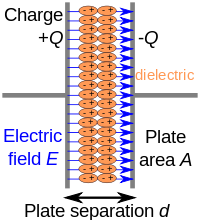
Photo from wikipedia
Experiments are performed using dry and humid air to clarify the effects of water vapour on the characteristics of surface dielectric barrier discharge (SDBD) and investigate its impact on the… Click to show full abstract
Experiments are performed using dry and humid air to clarify the effects of water vapour on the characteristics of surface dielectric barrier discharge (SDBD) and investigate its impact on the performance of the SDBD for decomposition of gaseous naphthalene in air stream. The current characteristics, including the discharge and the capacitive currents, are deeply analyzed and the discharge mechanism is explored. The results confirmed that the humidity affected the microdischarge distribution without affecting the discharge mode. Interestingly, it is found that the water vapour had a significant influence on the capacitance of the reactor due to its deposition on the discharge electrode and the dielectric, which, in turn, affects the power loss in the dielectric and the total power consumed in the reactor. Thus, the factor of the humidity effect on the power loss in the dielectric should be considered in addition to its effect on the attachment coefficient. Additionally, there was an optimum level of the humidity for the decomposition of naphthalene in the SDBD, and its value depended on the gas composition, where the maximum naphthalene decomposition efficiency in O2/H2O is achieved at the humidity level ∼10%, which was lower than that obtained in air/H2O (∼28%). The results also revealed that the role of the humidity in the decomposition efficiency was not significant in the humidified O2 at high power level. This was attributed to the significant increase in oxygen-derived species (such as O atoms and O3) at high power, which was enough to overcome the negative effects of the humidity.
Journal Title: Physics of Plasmas
Year Published: 2018
Link to full text (if available)
Share on Social Media: Sign Up to like & get
recommendations!